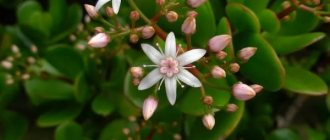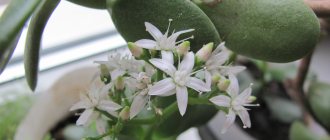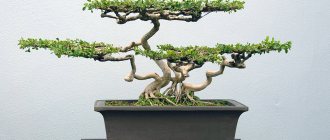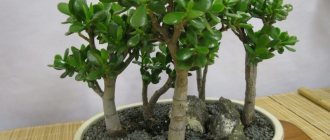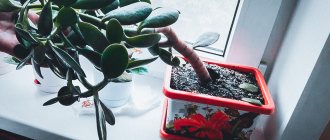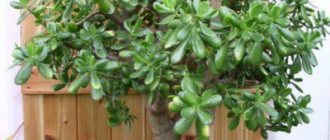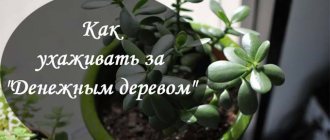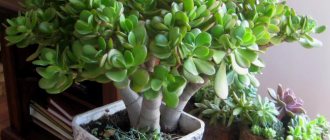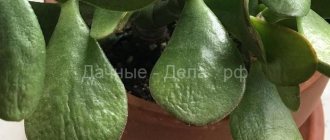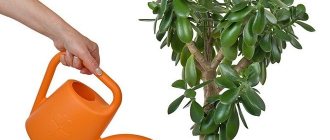Scientific name of money tree
If we talk about the scientific name, then in Latin it sounds like Crassula; the plant itself is a representative of the Crassula family. This includes 300-350 different species whose habitat is located in South Africa.
Money tree, appearance
Also, some plants are distributed throughout Tropical Africa, Madagascar and the Arabian Peninsula.
Helpful advice. It is recommended to wipe the leaves of the tree from dust every month. The plant really loves this procedure. Some owners even give the flower a shower of warm water, but be sure to cover the potting soil with a plastic bag or film so that excess moisture does not damage the root system.
The plant is very famous among indoor flower lovers. In principle, it doesn’t matter what you call it: crassula or crassula - it’s all one plant. Further material will be of interest to those who have not yet dealt with such a flower, but only want to purchase it.
Origin
The characteristic features of the fat woman are determined by its origin. Fleshy leaves and a thick trunk are peculiar reservoirs for water, which the plant stores during the rainy season. This is vital for survival in the deserts of South Africa and Arabia, in the hot, arid climate of Madagascar, Yemen and Australia, and the prairies of Nicaragua and Mexico. After all, this is where the fat plant grows. This plant from the genus of succulents has more than 300 species, grouped into 4 groups:
- Tree-like.
- Decorative flowering.
- Creeping (ground cover), lycophyte.
- Columnar.
Tree-like crassulas, due to the resemblance of their leaves to coins or rolled up bills, are also called money trees. This name just confirms the true homeland of the Crassula - the Middle East, the Arabian Desert. It was there that money was invented in the form of round coins, and it was there that the crassula with round “coin” leaves grows.
Interesting! China is fighting for the name of the homeland of the Crassula: there is a version that during the reign of the Han Dynasty, a plant with thick leaves received the name of the money tree and corresponding legends about the Tree that brings wealth appeared. Proof of this version can be the fact that during excavations of tombs of this time, bronze and faience copies of this plant were found.
However, during the Han Dynasty there were no round coins in China yet! So most likely the name of the money tree appeared in Arabia.
Now the plant is widely distributed in nature in the Southern Hemisphere. Crassulas are very diverse in appearance, their height ranges from a few centimeters to 3-4 m.
The color of the leaves varies, depending on the variety, from dense green to tricolor, the shape of the leaves - from round to funnel-shaped, similar to bills rolled into a tube.
Matte and shiny, large and tiny - the leaf blades of the money tree will satisfy the taste of any flower lover. The money tree is used not only to implement the principles of Feng Shui, but is used in landscape compositions , and in the most unexpected combinations.
Description of the money tree flower
Money Tree - how to plant it correctly to make money
It’s worth moving on to the appearance of the plant itself. Crassula, otherwise known as Crassula, is a succulent, i.e. a plant that can survive in dry areas by creating a supply of liquid in the leaves. The thick leaves of the indoor tree actually contain a large amount of water.
Crassula or Crassula
The Crassulaceae family includes approximately 350 varieties of similar plants. Some of them have a very small height of about 5 cm, others grow up to 3 meters. There are creeping and aquatic representatives, all of them are united by leaves of impressive thickness. Their shape depends on the variety; there are plants with leaf blades:
- oval;
- cylinder;
- rhombus;
- lanceolate shape.
Most often, a money tree located at home or in an office looks like a tree with a thick trunk. The older the flower, the thicker its trunk.
The leaf blades are interesting not only for their varied shape, but also for their color variations: from the usual bright green to silver or even spotted.
The benefits of an indoor flower
The Crassula tree has medicinal properties that will be useful for many diseases. The first thing the fat woman helps is to take away negative energy, improving the owner’s condition. The healing properties of money tree are similar to aloe. The plant will help cure runny nose and cough, relieve hemorrhoids and gastritis, help cope with acne and varicose veins, and whiten teeth.
The medicinal properties of Crassula infusions persist for a week after the leaf has been torn from the tree. Money tree leaves can not only heal, but also help the atmosphere of the house. Its medicinal properties extend to purifying the air from odors and pathogenic microflora. This action prevents the occurrence of respiratory diseases.
How does a money tree grow in nature?
Pilea peperomyoid or Chinese money tree
Under natural conditions, the plant reaches 1-2 meters in height, its trunk is about 30 cm thick. The leaves are small in size, elliptical in shape, the color of the plates is bright emerald, in some species there may be a red border around the perimeter. For domestic species of the money tree, flowering is uncharacteristic, but if such a rare occurrence occurs, then small white flowers appear, collected in inflorescences - umbrellas. The tree's homeland is in the Transvaal. This plant is also called ovata.
Money tree in nature
Purslane Crassula is a variation of the previous plant. Its trunk and branches are covered with aerial roots. Initially they are white in color, gradually darkening. Flowering is very rare for such a plant; it occurs in adulthood. The flowers are small in size, collected in paniculate inflorescences. The petals are white and pink.
What is the scientific name of the plant?
Despite the long list of “folk” names, biologists from all countries call the Crassula the same way: Crassula, which means “fat”.
The most common indoor plant - the money tree - belongs to the species Crassula Ovata - ovoid or oval Crassula. This name was given to the plant by its slightly elongated leaves. There are more than 200 types of Crassula .
The most decorative of them:
- Crassula Hummel's Sunset with distinct stripes and a red border;
- Crassula Ovata Oblique, which has a gradient leaf color;
- Crassula portulacea – portulac crassula, the aerial roots of which, when growing, form funnels with a red border along the edge;
- Crassula Ovata Oblique Tricolor is a variety of variegated Crassula derived from the species Oblique. The leaves of this plant have a characteristic bend: part of the leaf near the stem is downward, and the tip is up. The center of the leaves is green, followed by wide blurred white stripes, smoothly turning into pink-red towards the sides.
How to grow a big money tree
How to water a money tree at home
Under natural conditions, there are only a few varieties of plants that can reach a large size. If the owner of home flowers intends to grow a giant crassula, then it is recommended to listen to the following recommendations:
- Crassula needs a certain soil. The best option is soil suitable for cacti. It contains all the components needed for a money tree. As the “pet” grows, it will need to be replanted. This procedure is carried out every 2-3 years.
- The planting container is selected in such a size that it is suitable for the voluminous root system. When choosing a pot, look at the diameter of the crown; it should match the diameter of the pot.
- The procedure of pinching will help to get a large tree, otherwise the plant will grow as it is more convenient for it, this makes it unattractive.
- Fertilizers are applied monthly, adding them to the ground. The necessary fertilizers are purchased in specialized stores.
Big money tree - Providing proper lighting. It will not be possible to obtain a large crop if it does not have enough light. It is worth remembering here that the money tree comes from the African continent, so it requires large quantities of sunlight.
- Crassula needs moderate watering. They are carried out as the soil dries out. Excessive moisture causes the leaf blades to become soft and pale in color. Without correcting the situation, the plant will simply die.
- It is recommended to spray the flower daily, because... he is a great connoisseur of moisture.
Important point. Before planting a large fat plant, you need to make sure there is heavy drainage at the bottom of the pot. Otherwise, due to the severity of the crown, the tree will simply fall.
Superstitions associated with the plant
In order for the money tree to fully demonstrate its unusual properties and bring prosperity to the house, start growing the plant yourself, ideally, root the sprout yourself. The smaller the size of the sprout that you manage to root, the greater luck you will have in the near future. You can find a separate article on superstitions here.
- Crassula leaves must be regularly wiped from dust and dirt and counted. This is due to the saying that money likes to be counted.
- To stabilize and improve the owner’s financial condition, plant the plant in a red pot, or tie the existing pot with a red satin ribbon, and decorate it with red patterns or lines yourself. This will be a kind of “magnet” for cash flows.
- It is contraindicated to place the fat plant near electrical appliances. Their work prevents the flower from attracting funds.
- Wipe the leaves of the flower regularly and keep it clean. A dirty flower will not be able to work for you and help you solve financial difficulties.
- When Crassula begins to attract money to your family, take several cash coins of different denominations and place them in the shape of a slide near the flower pot. Coins will enhance the capabilities of the fat woman.
- After receiving financial profit, they select several coins, which are placed in a heap near a flowerpot with a fat plant. Coins are considered a powerful money magnet and enhance the influence and usefulness of the plant.
Varieties
The most popular variety of Crassula is oval; it includes varieties in large quantities. Leaf blades are 6 cm long and 3 cm wide. There is no petiole; the plate itself is attached to the stem.
The color of the leaves can be rich green or have a silvery tint; their edges are decorated with a red border. The flowers of the oval crassula are pink or white. The main advantage of this variety is its low maintenance requirements.
Tree Crassula
The height of the tree can reach 1.5 meters in height. The leaf plates are gray and also framed with a red border. The leaflets are approximately 9 cm long and 4 cm wide.
Crassula arborescens
The flowers are white, turning pink over time. It is recommended to place the tree-like representative on a western or eastern window.
Schmidt's Crassula
The leaves are characterized by a lanceolate shape with pointed tips. The upper part of the leaf is silvery-green, the reverse is red. The flowers of the bush are also red. This variety is popular in European countries; as an annual plant, it is planted every season.
Crassula Schmidt flowering
On a note. Direct sunlight on the flower leads to redness, wilting and falling of the foliage. In summer, it is recommended to move the plant to the balcony, and with the onset of cold weather, place it on a windowsill facing south.
Crassula moss
The plant has fleshy, narrow leaves with a pointed point similar to scales. The color of the flowers is yellow, but the culture is valued for its original branches hanging from the pot as it grows.
Moss variety
The height of the Crassula grows up to 25 cm. Some lovers of indoor flowers plant it in the same container with other succulents to obtain very beautiful compositions. Caring for this variety is easy, because... the plant is unpretentious. Life expectancy is more than 10 years. Reproduction occurs both by leaves and cuttings.
Rock Crassula
It is a representative of creeping plants, reaching a height of 0.5 m. The stems are thin, with small thick leaves decorated with a red border.
Skalnaya
The color of the flowers can be pinkish or yellow.
Spot Crassula
It is a shrub with leaf blades located close to the stem. The leaves themselves are ovoid in shape and have a point at the top. They are greenish in color, with a silvery tint and dark dots. The crop will bloom with white flowers.
Crassula punctata
Good to know. With the onset of cold weather, the money tree goes into a dormant state; during this period it is recommended to place it in a room where the temperature is about +5°C. Watering is carried out once every 20 days.
Portulaca Crassula
It has bright glossy green leaves in the shape of an ellipse with a thickening in the middle and a thinner part at the edges. As the shoots begin to develop, they become thicker. This plant can reach 2 meters in height.
Purslane
Cooper's Crassula
The shoots of this plant are especially interesting. The lower part is characterized by vertical growth, the upper part is characterized by a downward slope. The more they (the shoots) grow, the more they press against the ground. The leaves of the flower are elongated, with red specks, which gives the crop a very elegant look.
Cooper's Crassula
Caring for her is as easy as caring for the rest of the family.
Care
Planting home crops in open soil is not recommended. If the weather is good, you can take the pot out into the fresh air. This procedure will have a beneficial effect on the well-being of the plant.
Worth knowing! Being outside, in the fresh air, often ends with the money tree being attacked by aphids. In order to recognize the problem in time and begin to fight harmful insects, it is necessary to periodically inspect the crop.
Despite the fact that Crassula has rather harsh living conditions in its homeland, there are some aspects that are worth knowing in order to grow a healthy flower in the house. Money tree care at home:
- Crassula loves light, but the plant does not like direct sunlight. To provide the flower with diffused lighting, it is recommended to place the tree on a stand or shelf under the window. In the summer, it is worth thinking about shading the glass (especially for south and south-west windows). On the north side, the plant is placed directly on the windowsill;
- Dry air is not a problem for succulents; due to frequent changes in humidity, various diseases can develop. The plant has difficulty adapting to frequently changing conditions;
- Adult Crassula has a negative attitude towards transplants, therefore, if there are no vital indications, it is best to leave the plant alone;
- Excessive watering leads to rotting of the root system, which ends in the death of the flower. In spring and summer, the crop is watered once a week. Use soft, settled water at room temperature;
- Frequent feeding should also be avoided. It will be enough for the plant to be fertilized once every six months;
- Contraindication – drafts, they provoke illness. If it is necessary to ventilate the room in winter, it is recommended to take the flower out of the room or cover it for this time. Prolonged exposure to cold air leads to the fact that leaves begin to fall off the crop.
On a note. The mealybug is not averse to settling on a money tree, which will cause both the plant itself and its owner great trouble. Periodic inspections of the flower and carrying out preventive measures will help to avoid this. If, however, harmful insects are found, you will have to use insecticides to treat the plant.
Content temperature
In spring and summer, the optimal temperature for Crassula is +20-25°C. With the onset of suitable weather conditions, it is recommended to take the flower outside or onto the balcony, because... the tree reacts poorly to insufficient fresh air.
Mealybug
In winter, the most comfortable mode is +15°C or lower, but not less than +4°C. If you overwinter a money tree at room temperature, you may encounter unpleasant situations such as wilting and falling leaves. It is not recommended to place the pot next to the central heating radiator.
The unpretentiousness of the Crassula makes the money tree a favorite of many gardeners. If all care recommendations are followed, the plant will look great, delight the owner for decades, and will not require treatment.
Why is Crassula called that?
To begin with, Crassula is known for its longevity and can live up to 100 years. As it ages, it develops a thick woody stem and branches, giving it the appearance of a tree. And the ovoid, fleshy leaves, very similar to coins , create lush foliage. Most likely, this is why this plant in Asia has become associated with money.
A scattering of green coins. Photo used as illustration. Source: Yandex.Images
According to Feng Shui philosophy, Crassula brings good luck, wealth, prosperity and fortune to the home. And its miniature size and unpretentiousness have made this plant popular all over the world. Thus, the tree has become a popular gift for a wedding, housewarming or opening a business.
In Asian culture, there is a legend about a poor man who prayed to gain wealth. One day, while walking through the forest, he came across this plant and brought home one seedling, considering it a sign of fate. As a result, he became rich by selling seedlings. This seemingly simple story may not be far from the truth.
There are actually several types of Money Trees, but they are all native to East Asia (mostly grown in Taiwan and Thailand). To increase sales, some people labeled plants as bringing money or good luck. Tourists (especially from China) bought them and popularized them in their homeland along with the labeling. And the only ones who made real profit from this were enterprising gardeners.
